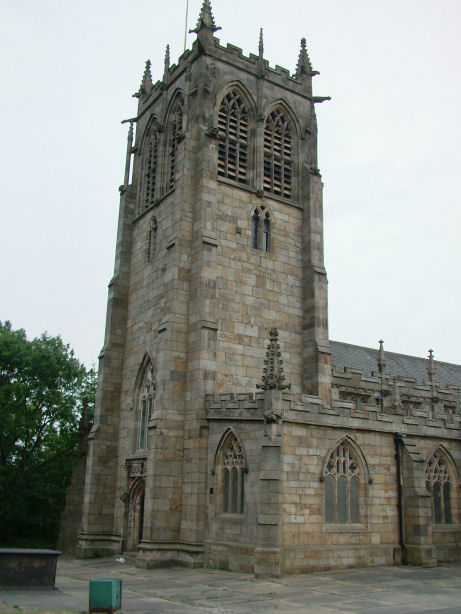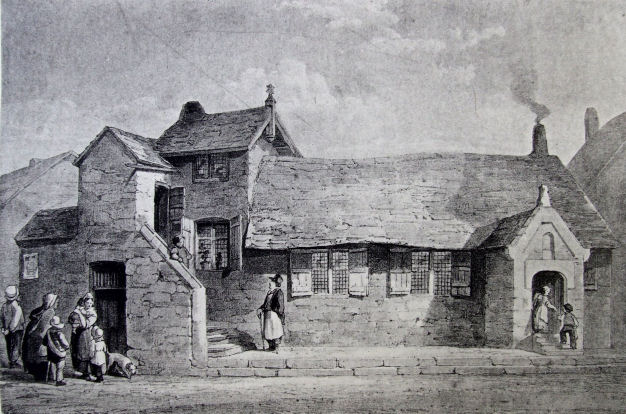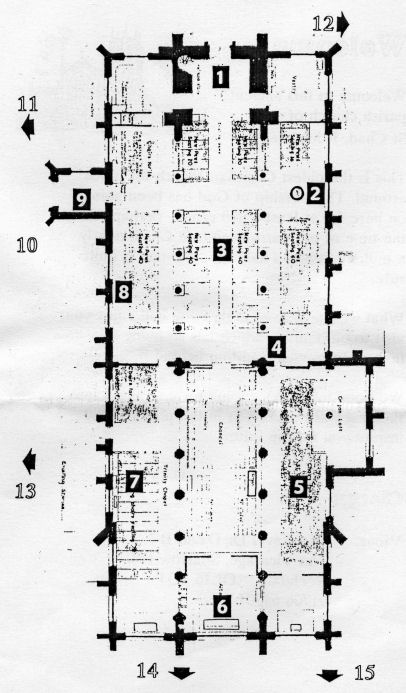
The Marland Family
Marland places: Rochdale
St Chad's Church
 |
(text
adapted from the Church guide)
There has been a church on this hill overlooking the
town centre for more than 1,000 years - perhaps since the time of
our patron saint, St Chad, nearly a millennium-and-a-half ago. |
-
The TOWER is the oldest part of the church, with stonework going back to the 1200s. It was raised in height and a chiming clock removed in 1872. The octagonal stone clock-face is built into the floor. The fine West window, "Faith, Hope and Charity,'' was designed by the pre-Raphaelite artist Edward Burne-Jones, and made by designer and craftsman William Morris.
-
The FONT is believed to be thirteenth to fourteenth century. It was lost for some 200 years, buried in the churchyard to hide it from Cromwell's Puritans during the Civil War in the mid-seventeenth century, and found by accident by a man planting a tree in 1893. Records show that 175 babies were baptised in St Chad's in one day in 1837.
Gracie Fields was christened here as Grace Stansfield of 9, Molesworth Street, on 2 February 1898.
-
The NAVE was partly re-built and extended in the mid 1800s, retaining the 13th century PILLARS, alternately octagonal and round like those in Canterbury Cathedral. The damaged heads around two of the columns are thought to have been defaced by Cromwell's Roundheads.
-
The PULPIT, dated 1907, has carving showing Christ delivering the Sermon on the Mount, with figures of St Peter and St Paul either side.
-
A CHAPEL dedicated to St Katherine has existed since at least 1487, but the present chapel was part of an 1886 re-building of the chancel. The altar rails have the carved mouse trademark of the woodworker Thompson of York. The military standards include the laid-up regimental colours of the 6th Battalion Lancashire Fusiliers. The dark wooden sideboard dated 1643 is a Byron family heirloom, presented to thefirst Baron Byron of Rochdale to mark the grant of the peerageby Charles I... his reward for leading Royalist troops at the Civil War battles of Edge Hill and Worcester.
The Byron family were Lords of the Manor of Rochdale, and had connections with the Parish Church, from the 1400s, until the poet Lord Byron - the 6th Baron - sold the rights in 1822
-
The East window over the ALTAR, a fine example of Victorian stained glass - dated 1885 - has the words of the Te Deum lettered through it. Almost hidden in the design is a representation of a pelican, a traditional symbol of Christ's sacrifice. In the upper windows of the CHANCEL, 28 angels play their musical instruments above the choir stalls. The stalls themselves are of mixed age. Some have woodwork from the 1600s, and others from the 1400s came from Canterbury Cathedral. The Byron family arms are on one of the pews.
-
The TRINITY CHAPEL also goes back to 1487, and the altar table and rails are from the original chapel and date back to the 16th century. But the memorial brasses on the wall are fakes, installed in 1847 in the style of the 16th century by a Lord of the Manor to give him a spurious pedigree. The windows with the coats of arms of Rochdale families are fine heraldic glass by Thomas Williment (1786-1871)
Trinity Chapel was founded in 1487 by Brotherhood of the Holy Trinity, which included Doctor Adam Marland (Dean of Kendal and Vicar of Buckland, Berkshire). The family retained a share until it was sold by James Marland of Marland in 1665 to Alexander Butterworth of Belfield. Adam Marland had been a feoffee of Ralph de Belfeld in 1433. (Fishwick)
-
The brass PLAQUE on the South wall near St Chad's window commemorates the visit of the Queen and Prince Philip in 1994, when the church celebrated 800 years of recorded history. The window to the right of it is a memorial to Sir Clement Royds, local banker and MP - 1895-1905 - whose family were benefactors to the church.
-
In the PORCH, on your way out, you will see the list of Vicars of Rochdale going back to 1194. Three had streets in the town named after them: Drake, Maclure, Molesworth.
Henry Marland was Vicar from 1426 to 1455/56; he was thus a contemporary of Adam Marland. The initials HM are said to have been visible on the roof timbers of Trinity Chapel until 1823. (Fishwick)
-
The GRAVESTONES now paving the church pathways record Rochdale's social history down the centuries, giving names, addresses and occupations - and underlining the dreadful infant mortality rates of past generations. The oldest is dated 1656.
-
The SUNDIAL on the lawn was erected in 1783 at a cost of £4 4s 6d. It was originally sited where the War Memorial now stands.
-
The STONE WALL at the North-west corner is reputed to pre-date 1066, though it was rebuilt in the early 1900s.
-
Rochdale's TOWN STOCKS, dated 1688, were last used to shackle a wrongdoer, Billy Pod, in 1822.
-
The FENCED GRAVE at the East end is that of Rochdale dialect poet, caricaturist and political satirist John Collier, "Tim Bobbin," who died in 1786.
-
The 122 STEPS down to the Town Hall were re-built in 1660 with eight loads of stone from Blackstone Edge. They originally led down to Packer Street through rows of terraced houses.
If you would like to know more of the fascinating story of St Chad's, "Top o'th' Steps", a comprehensive history with colour pictures, is available in church, price £3.
In Summer, St Chad's is open to visitors on Tuesdays, Wednesdays, Thursdays 2-4 pm until the end of August. Guided tours of the church can be arranged for organisations, school parties or study groups.
Vicar: The Rev'd Dr David B Foss
The Vicarage, Sparrow Hill
Rochdale OL16 1QT
01706 645014
See also:
Rochdale Grammar School

The School was founded in 1564 and opened in 1565, off St Chad's churchyard at the top of School Lane. Sir John Byron had been in dispute with the Archbishop of Canterbury, Matthew Parker, over the "vesting" of the tithes of Rochdale, i.e. transferring the rights in them from lay collectors to the Church; the School was set up in compensation.
Among the earlier masters (most of whom were of local families and generally clergymen) was Robert Marland, son of James Marland of Marland. He resigned in 1610. (Fishwick)
The school offered instruction "free of charge in the learning of true piety and the knowledge of the Latin tongue" in a one-storey building until 1847, when it was replaced by a new building on Sparrow Hill. By 1864 its pupils had risen in number from 16 to 40, and it saw out the century, finally closing in 1902.
For a fuller account, see Public service grew out of dispute (Rochdale Observer, 2006)
| Webmaster: Andrew Gray |
Edited: 18 December 2015 |
